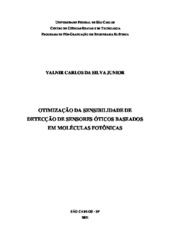| dc.contributor.author | Junior, Valnir Carlos da Silva | |
| dc.date.accessioned | 2021-08-23T11:10:48Z | |
| dc.date.available | 2021-08-23T11:10:48Z | |
| dc.date.issued | 2021-05-21 | |
| dc.identifier.citation | JUNIOR, Valnir Carlos da Silva. Otimização da sensibilidade de detecção de sensores óticos baseados em moléculas fotônicas. 2021. Dissertação (Mestrado em Engenharia Elétrica) – Universidade Federal de São Carlos, São Carlos, 2021. Disponível em: https://repositorio.ufscar.br/handle/ufscar/14785. | * |
| dc.identifier.uri | https://repositorio.ufscar.br/handle/ufscar/14785 | |
| dc.description.abstract | The integrated photonics has been consolidated in the last years in part by the ability to meet the
recent demand for the miniaturization of photonic devices. Waveguides and optical microcavities
stand out among the main components used in integrated photonics. Waveguides consist of
structures capable of guiding electromagnetic waves between their starting and endpoints, based
on the difference in the refractive indices of two or more materials to keep light confined by guiding
them inside the chip. The optical microcavities are simple photonic structures, mostly in the form
of disks or rings, which allow the photons to be strongly confined in a tiny volume. Several
integrated photonic devices take advantage of the optical characteristics of these structures, which
combined, guarantee the design of integrated photonic chips, fabricated in laboratories of
universities, companies, and foundries. One of the largest applications of integrated photonic chips
is in optical sensors, called lab-on-a-chip, which allows several lab functions on a single chip in
order to achieve high-performance automation and screening. In particular, sensors based on
photonic molecules (PMs), which are combinations of optical microcavities coupled with each
other, use a detection method linked to the variation of resonances of the microcavities in the
presence of a change in the refractive index of the environment around the microcavities. The
resolution of these sensors is highly dependent on the dimensions of the transverse session of the
waveguide where the light is confined. One of the main challenges of this type of sensor is the
optimization of its sensitivity, without there being major changes in the fabrication methods to
obtain them once they are well established in the industry. In this sense, the focus of this project
was to investigate methods to increase the sensitivity of integrated sensors based on PMs from the
optimization of the dimensions of the components that constitute them to the implementation of
strangulation in the waveguide that forms the detection rings. This strangulation will ensure an
increase in the evanescence of the propagating modes in these cavities, responsible for the detection
of the sensors, increasing significantly its sensitivities. | eng |
| dc.description.sponsorship | Não recebi financiamento | por |
| dc.language.iso | por | por |
| dc.publisher | Universidade Federal de São Carlos | por |
| dc.rights | Attribution-NonCommercial-NoDerivs 3.0 Brazil | * |
| dc.rights.uri | http://creativecommons.org/licenses/by-nc-nd/3.0/br/ | * |
| dc.subject | Guia de onda | por |
| dc.subject | Waveguide | eng |
| dc.subject | Microcavidades | por |
| dc.subject | Microcavities | eng |
| dc.subject | Molécula fotônica | por |
| dc.subject | Photonic molecules | eng |
| dc.subject | Sensor óptico | por |
| dc.subject | Optical sensor | eng |
| dc.title | Otimização da sensibilidade de detecção de sensores óticos baseados em moléculas fotônicas | por |
| dc.title.alternative | Optimization of detection sensitivity of optical sensors based on photonic molecules | eng |
| dc.type | Dissertação | por |
| dc.contributor.advisor1 | Barêa, Luís Alberto Mijam | |
| dc.contributor.advisor1Lattes | http://lattes.cnpq.br/7929868663210908 | por |
| dc.description.resumo | A fotônica integrada se consolidou nos últimos anos, em parte, pela capacidade de suprir a
recente necessidade de miniaturização dos dispositivos fotônicos. Dentre os principais
componentes empregados em fotônica integrada, destacam-se os guias de onda e as microcavidades
óticas. Os guias de onda consistem em estruturas capazes de guiar ondas eletromagnéticas entre
seus pontos de extremidade, baseando-se na diferença dos índices de refração de dois ou mais
meios para manter a luz confinada, guiando-as dentro do chip. Já as microcavidades óticas, são
estruturas fotônicas simples, majoritariamente na forma de discos ou anéis, que permitem confinar
fortemente os fótons em um volume diminuto. Diversos dispositivos fotônicos integrados se
beneficiam das características óticas dessas estruturas, que combinadas, garantem o design de chips
fotônicos integrados, fabricados em grandes laboratórios de universidades, empresas e foundries.
Uma das maiores aplicações dos chips fotônicos integrados está em sensores óticos, como é o caso
do chamado laboratório em um chip (lab-on-a-chip), que permite várias funções de laboratório em
um único chip, a fim de obter automação e triagem de alto rendimento. Em particular, os sensores
baseados em moléculas fotônicas (Photonic Molecules, PMs), que são combinações de
microcavidades óticas acopladas entre si, utilizam-se de um método de detecção atrelado à variação
de ressonâncias das microcavidades na presença de uma modificação no índice de refração do
ambiente ao redor das microcavidades. A resolução desses sensores possui grande dependência das
dimensões da sessão transversal do guia de onda onde a luz está confinada. Um dos principais
desafios deste tipo de sensor está na otimização da sua sensibilidade, sem que haja grandes
mudanças nos métodos de fabricação para obtê-los, uma vez que são bem estabelecidos na
indústria. Nesse sentido, o foco desse projeto foi investigar métodos para incrementar a
sensibilidade de sensores integrados baseados em PMs, a partir da otimização das dimensões dos
componentes que os constituem, bem como implementar um estrangulamento de uma parcela do
guia de onda que forma o anel de detecção, o que garantiu um aumento na evanescência do modo
propagante nessa cavidade, responsável pela detecção do sensor, aumentando significativamente
sua sensibilidade. | por |
| dc.publisher.initials | UFSCar | por |
| dc.publisher.program | Programa de Pós-Graduação em Engenharia Elétrica - PPGEE | por |
| dc.subject.cnpq | ENGENHARIAS::ENGENHARIA ELETRICA::TELECOMUNICACOES | por |
| dc.publisher.address | Câmpus São Carlos | por |
| dc.contributor.authorlattes | http://lattes.cnpq.br/4925370507459259 | por |


